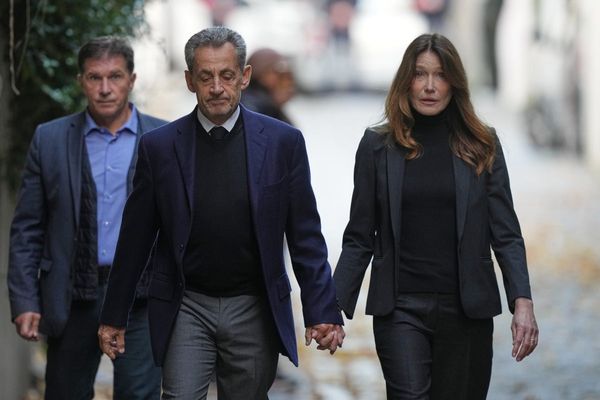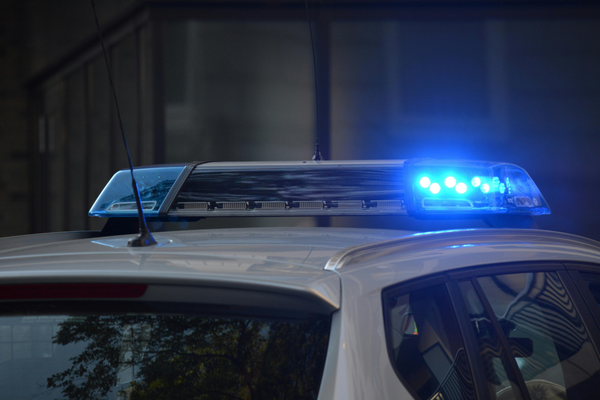Scout* barely realised that something round and hard, with smoke coming from it, had landed in front of them before it exploded.
Pain suddenly shot through their leg and arm. Scout fell to their knees before someone nearby helped them rush out of the area.
“My ears were ringing, my eyes were stunned by the flash,” Scout tells Guardian Australia.
“It was like in the movies when a bomb goes off in a war zone.
“I was really in shock for a little while, it was hard to walk on my leg, and I could feel a burning sensation, but the adrenaline … basically set in.”
Vision of the protest in Melbourne last month shows how a Victoria police officer detonated a munition known as a “stinger grenade” where Scout was standing.
The footage shows a member of the Public Order Response Team (Port) skirting behind a row of officers in a standoff with protesters.
The Port member then moves forward, crouches and lobs the grenade towards the protesters via an underarm throw. It strikes an umbrella, which was being used by one protester to avoid being sprayed with oleoresin capsicum (OC) foam, and lands on the road. For about a second, it seems to be either unnoticed or ignored.
Then it explodes.
The stinger grenade is designed as a crowd-control device. It makes a loud noise, creates a blinding flash and fires rubber projectiles.
According to its manufacturer, some versions of the grenade can also discharge chemical agents or OC spray, but it is unclear which model is used by Victoria police.
It is one of a suite of “less lethal” options embraced by police for use at protests in the past five years, despite such weapons being linked to a series of serious injuries or even deaths, including a woman in France who researchers found lost an eye because of a stinger grenade.
The use of stinger grenades by police has also led to legal action by protesters, including in the US, after they were used during Black Lives Matter rallies.
‘It’s a bad day for Melbourne’
At hospital later that day, Scout realised they had burns near their knee and groin, even though they were wearing pants. What felt like hot metal had torn holes straight through them. They also had a burn on their right wrist.
In the next three days these burns became ringed with bruises, the colour of overripe banana. Scout says x-rays were carried out over concern that the skin may have been penetrated by shrapnel.
About the same time Scout was in hospital, Supt Wayne Cheesman was lashing the behaviour of the counter-protesters in the city that day, including those who allegedly threw rocks at officers. He said a group were repeatedly violent against his officers, several of whom had been injured, and police have subsequently released photos of people – none of which included Scout – wanted for questioning.
He also said at the time that no injuries to protesters had been reported to police.
Cheesman, however, confirmed that police had used two stinger grenades and four flash-bang devices, along with rubber bullets and VKS Pepperball guns – pellets of pepper spray fired from a semi-automatic “launcher”.
“It’s a bad day when we’re using those things, it’s a bad day for Victoria police, it’s a bad day for Melbourne, it’s a bad day for our community, we don’t want to be in that position,” Cheesman said.
“But at the same time I don’t think our members should be target practice for people who want to hurt us.”
Sign up: AU Breaking News email
Scout says they had not been violent towards police, and had been standing with a group – including media photographers – when the explosion occurred. They are one of two people considering legal action against police for injuries caused by the 19 October explosion, near the intersection of Spring and Little Bourke streets.
Footage shows that neither Scout nor the other person considering legal action were resisting police at the time they were injured.
Guardian Australia also spoke to a photographer who does not know the pair but was nearby when the grenade exploded. He said police had not shouted any warnings or given any indication the device would be used before it detonated. No such warnings can be heard on the footage.
The photographer, speaking on the condition of anonymity given the nature of his work, confirmed that he had also felt debris from the explosion but had not required medical attention.
Neil Corney, a researcher at the Omega Research Foundation, a UK-based organisation that analyses military, security and police technologies, reviewed footage of the explosion.
He says while the type of stinger grenade used was unclear, those that eject rubber pellets are inherently dangerous and there are calls for them to be banned. He says the head of the grenade, the lever and its body could all cause serious injury if “expelled” with sufficient energy.
“Fragments are expelled in a completely random pattern, and so it is impossible to reduce the risk of hitting a vulnerable part of the body,” Corney says.
He says he believes that the use of OC spray by other police at the scene was successful at moving some protesters on. Scout was not targeted by the spray.
“The officer throws it underarm but it is released from his hand in the air, not rolled along the ground,” Corney says. “This is dangerous at such short range, as the risk is it explodes in the air, and with people moving it may detonate in their face …
“In this incident there is no immediate threat to the officer themself, not to any other officers in the immediate area.”
‘Indiscriminate’ use of force
The force’s own guidelines state that when stinger grenades, known as crowd control munitions are used, police “should consider, and where practicable, facilitate immediate access to medical attention”.
“If any person is injured … the Police Forward Commander must arrange after care or medical attention at the earliest opportunity,” the guidelines say.
Scout says there was no such offer on 19 October.
Police are understood to believe the device was used in line with its guidelines.
Victoria police were asked a series of questions about the incident and stinger grenades, including details about how many projectiles they contain, the intended use of the devices, and whether the officer who used the device had completed a “use of force” report and a CCM debrief report that “incorporates human rights considerations” as required under its guidelines.
“Police do not attend protests with the aim of using this tactical equipment, but it is always in response to the actions of protesters whether it be violence between different groups, or towards officers,” a spokesperson said in their response.
“Officers working at protests have reported being threatened, hit with objects such as bottles and rocks, and being grabbed, pushed or held.
“Any sort of violent and disruptive behaviour in our community is unacceptable and will not be tolerated by police.”
Jeremy King from the law firm Robinson Gill, which is representing Scout and another protester, says the footage shows “how indiscriminate the police use of force is and how police almost inevitably employ a one-size-fits-all approach to policing protests”.
King says there are legitimate reasons for police to use force at protests, such as when people ignore directions or are violent, but points to a lack of oversight in determining whether that force is reasonable.
“What is the lawful purpose of a stinger grenade, given force should only be used by police to affect something?” he said.
“What are they actually seeking to do here? Because it can’t be to just stop people protesting.”
*Name has been changed







